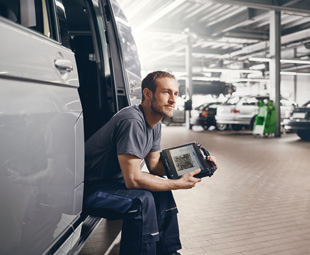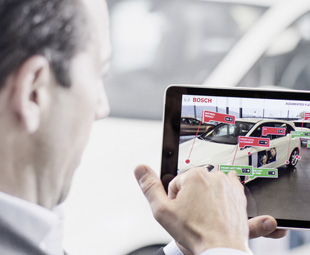Where did I leave my tablet?

Unlike their predecessors, today’s mechanics could almost be considered computer technicians. Maintaining a modern-day vehicle requires more than just a good set of spanners … We explore the digital side of vehicle maintenance
As a vehicle technician, there is a high probability that the “toolset” (literal and figurative) one has today will be increasingly out of date tomorrow. Okay, so the basic mechanical workings of a vehicle remain the same, but to access their deepest, darkest secrets has long required more than a trip round the block and a keen ear.
Sure, for as long as the internal combustion drivetrain is around, many traditional skills will not disappear … but take into account that development in electric propulsion is growing exponentially and it’s clear that the landscape is changing rapidly.
Vehicle technicians, mechanics and whisperers therefore need to keep abreast of the times. According to Bosch, automotive workshops are on the cusp of a new era…
During September, at Automechanika Frankfurt, the company demonstrated notable new technologies that will change the workshop environment.
“Increasing digitisation and connectivity will shape the biggest change for all market players in the aftermarket segment. While this trend will bring forth major opportunities, it also represents changes so significant that it could pose an existential threat for some actors in the market,” says Uwe Thomas, president of Bosch Automotive Aftermarket.
 “Service, high levels of transparency, attractive services and customised customer support are becoming increasingly important for workshops and those in parts distribution,” he adds.
“Service, high levels of transparency, attractive services and customised customer support are becoming increasingly important for workshops and those in parts distribution,” he adds.
“This new reality is based on the growing connectivity of the vehicle and its surroundings – telematics data, for example, which allows fleet managers to schedule maintenance more accurately. At Bosch Automotive Aftermarket, the connected workshop is now our central focus,” he says.
Hans-Peter Meyen, executive vice president Product Area Diagnostics and Engineering, Bosch Automotive Aftermarket, explains: “Our aim is to optimise the work processes of workshops. What’s more, we want to improve the flow of IT-related data at workshops. In short: we aim to achieve more efficiency and greater transparency for workshops and their operators.”
How does the company aim to achieve this? By taking digitisation and the connected vehicle a step further with, for example, two of its latest developments: Connected Repair and augmented reality (AR).
The new Connected Repair software connects all systems within a workshop. It allows for a vehicle’s data and its entire history to be quickly called up, which simplifies processes, making the job more efficient and saving time and money.
“Connected Repair connects all Bosch diagnostics systems in the workshop. This means that all computers have immediate access to all the data relating to a vehicle. Registering the vehicle in the database is all that is required,” says Meyen. “With this technology, we have simplified the planning process for visits to the workshop.”
In the case of scheduled routine service tasks, the time required is reduced by up to 60 percent. Connected Repair also includes a smart inventory and tool management component – called ToolNet.
Using different tracking technologies, such as RFID, ToolNet provides a digital image of the use, maintenance, rental and tracking of tools for the optimisation of workshop and repair processes.
Furthermore, Bosch’s telematics data and IT infrastructure allows fleet operators to receive a good overview of a vehicle’s status, the driver’s driving style and necessary repairs. This, however, takes the role of the workshop another step further.
“Smaller fleet operators, such as delivery services or service providers in the trades, can easily hand over fleet management to workshops. In so doing, workshops can coordinate required maintenance work at an early stage and thus reduce a vehicle’s down time. This is the basis of close cooperation between fleet operators and workshops,” suggests Meyen.
Given this increase in connectivity, data security is an important factor. Protecting a customer’s data is key to the success of such systems. “Thanks to our encryption technologies and high industry standards, we can ensure that our customers’ data is safe from hacker attacks and data theft,” assures Meyen.
With its second development, Bosch has used AR to open the door to new work methods for the modern workshop to address increasingly complex technical challenges. “For young people, AR is already an established part of the everyday life. To them, the real and virtual worlds are naturally connected to one another,” says Thomas.
Bosch’s Common Augmented Reality Platform (or CAP), has made it possible to use AR on an industrial scale for the first time.
In the workshop, the employee points a smartphone or tablet camera at the vehicle and, on the screen, will see important additional information on a real image of the vehicle. This can include explanations such as operating instructions or circuit diagrams, three-dimensional objects, pictures, or videos. Information concerning special tools and the next working step is displayed as well.
“This information helps provide a deeper understanding of the product in question and makes it easier to detect malfunctions,” adds Meyen.
So, workshops are well on their way to becoming their own sort of digital playground – but at least actually fixing the problem still requires a good old-fashioned toolbox…
Published by
Focus on Transport
focusmagsa




